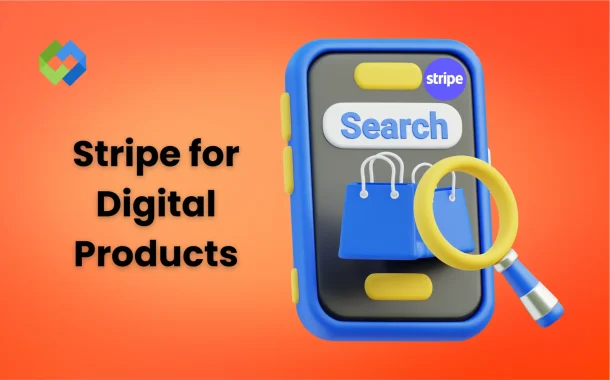Stripe offers useful features for digital sellers. You can sell one-time products or subscriptions. It also helps with taxes, refunds, and recurring payments. Stripe has strong security to protect customer data. You can connect it with websites, apps, or platforms like WordPress and Shopify.
Table of Contents
Table of Contents
Setting Up Stripe for Digital Products
Create a Stripe Account
Go to the Stripe website and sign up for a free account. You’ll need to enter your email, set a password, and choose your country. Once inside, Stripe will ask for your personal and business details. This includes your name, business type, and bank account information. This is necessary so Stripe can transfer the payments you receive.
Add Your Digital Products
After account setup, you can start adding your products. Stripe lets you create one-time items or recurring subscriptions. You can set product names, prices, and how you want customers to pay.
Choose Integration Method
You can connect Stripe with platforms like WordPress, Shopify, or Gumroad using built-in plugins. If you want more control, you can use Stripe Checkout or its API. Both are good for handling payments for digital files, software, or online services. This makes the payment process smooth and easy to manage.
Integrating Stripe with Your Digital Platform
Using Stripe with Website Builders
If you’re using platforms like WordPress, Shopify, Wix, or Gumroad, integrating Stripe is simple. These platforms offer built-in support or plugins for Stripe. You just log into your Stripe account through your site’s settings and connect it. Once connected, you can add payment buttons or checkout pages to start selling digital products like eBooks or courses.
Using Stripe Checkout
Stripe Checkout is a quick way to start. It provides a secure, mobile-friendly payment page. You don’t need to design your own form. Stripe handles the layout, payment options, and even updates if new features are added.
Using Stripe API for Custom Setup
If you have a custom website or app, you can use the Stripe API. It gives more control to developers. You can build your own payment flow, offer coupons, or create complex subscriptions. This is ideal for advanced setups or digital services that need more flexibility.
Managing Digital Product Delivery
Automatic Delivery with Platforms
Stripe doesn’t directly handle file delivery, but it works well with platforms that do. If you’re using WordPress, Gumroad, SendOwl, or similar tools, you can automate product delivery. After someone pays, these platforms send the file or access link instantly. You can upload your product (like a PDF or course link) and let the platform manage everything.
Using Webhooks for Custom Delivery
If you’re building a custom website or app, Stripe webhooks are a great option. A webhook sends a message to your server when a payment is successful. Your system can then automatically send a download link, activate an account, or give access to digital content. This method is more flexible and works well for software, memberships, or custom apps. It keeps things fast, secure, and fully automated.
Protecting Your Digital Files
When delivering digital products, it’s important to protect them from being shared without permission. You can use expiring download links, limit downloads per user, or add watermarks using this tool. ensures your files remain protected while maintaining a professional presentation. Some tools also let you track how often a product is accessed. These methods help control unauthorized sharing and keep your content safe.
Handling Taxes and Compliance
When selling digital products, taxes can be tricky. Different countries have different rules for digital goods. You might need to collect VAT in the EU, sales tax in the U.S., or GST in other regions. Handling all this manually can be a hassle, especially if you sell globally. That’s where Stripe helps.
Stripe offers a tool called Stripe Tax. It figures out where your buyer is from and automatically applies the correct tax rate. You don’t have to worry about setting tax rules yourself. During checkout, Stripe shows the added tax clearly to the buyer. This helps avoid confusion and keeps your pricing transparent.
You can choose where you want to collect taxes. If you only sell in certain countries, you can limit your settings to those places. After each sale, Stripe keeps track of the taxes collected. You get clear reports, which makes filing easier later.
Customer Support and Refund Handling
Responding to Customer Questions
Good support builds trust when selling digital products. Buyers may ask about downloads, access, or billing problems. Stripe keeps detailed records of every payment. You can see when a payment was made, how much was paid, and what product was purchased. This makes it easier to solve customer problems quickly and clearly.
Processing Refunds Easily
If a buyer asks for a refund, you can handle it directly from your Stripe dashboard. Just find the payment, click refund, and choose full or partial. Stripe sends the money back to the customer’s card. It’s simple and fast. You don’t need extra plugins or services to do it.
Dealing with Chargebacks
Chargebacks happen when a customer disputes a payment. Stripe helps you respond with proof, like access logs, email receipts, or download history. Having clear refund policies on your website also helps prevent chargebacks.
Conclusion
Stripe is a smart choice for selling digital products. It helps you accept payments easily and safely. You can sell ebooks, courses, software, and more without much setup.
It also supports taxes, refunds, and product delivery. Whether you’re using a platform or your own website, Stripe gives you the tools to manage everything. It keeps your business running smoothly and your customers happy.














